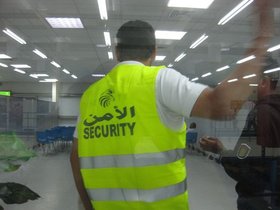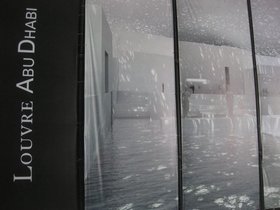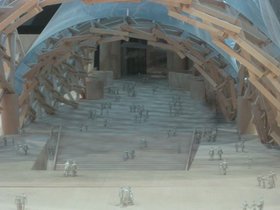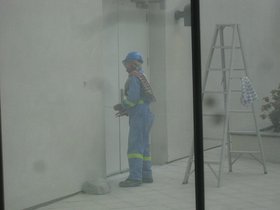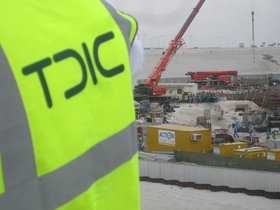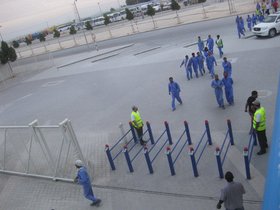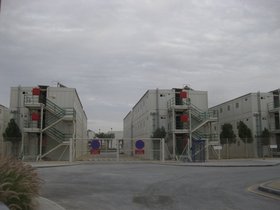Essays
Saadiyat and the Gulf Labor Boycott
INTRODUCTION
Anthony Downey
The impact of globalisation can be felt in a wide range of interconnected activities and circumstances, including the way cities and communities are developing as a result of deregulated labour conditions and patterns of contemporary migration. These processes are underwritten by a neoliberal agenda that ensures an imbricated and predicative form of labour exploitation. In May 2009, the human rights group Human Rights Watch (HRW) published a damning report on labour conditions in Abu Dhabi, which included evidence of widespread abuse of migrant labourers including, but not limited to, forced labour, surrender of passports, withholding of wages, and working conditions deemed unfit if not fatal.
In March 2012, a follow-up HRW report found improvements in the treatment of migrant workers, but protection gaps remain. The following essay is by Gulf Labor, a coalition of international artists working to ensure that migrant worker rights are protected during the construction and maintenance of museums on Saadiyat Island in Abu Dhabi. Whilst Gulf Labor also note improvements since the beginning of their involvement, they also observe continued failings across a number of areas when it comes to equitable labour rights in the building of Saadiyat Island.
This essay is very much a collaborative effort, written by Haig Aivazian, Ayreen Anastas, Doug Ashford, Doris Bittar, Rene Gabri, Mariam Ghani, Naeem Mohaiemen, Walid Raad, Andrew Ross and Gregory Sholette, who make up the Gulf Labor working group alongside Shaina Anand, Tania Brugera, Sam Durant, Brian Holmes, Rana Jaleel, Guy Mannes-Abbott, Michael Rakowitz, Ashok Sukumaran, Beth Stryker and Murtaza Vali. Fellow member, Hans Haacke, has made a series of images of Saadiyat Island available to Ibraaz as part of 005 Projects, while Gregory Sholette has provided the photographs illustrating this essay. Ibraaz would like to personally thank Naeem Mohaiemen for all of his tireless work in bringing this essay report together.
SAADIYAT AND THE GULF LABOR BOYCOTT
Changes on Saadiyat Island Since the Boycott Began
Haig Aivazian: When it comes to Saadiyat Island and the workers' conditions there, we can talk about the changes observed since 2011. However, the history of the boycott starts a little bit earlier. While it is true that the boycott was made public in 2011, several key initiatives precede that date, including a letter signed by 43 artists sent to the Guggenheim in 2010 seeking guarantees of workers' rights. This letter was sent after members of Gulf Labor consulted with Human Rights Watch (HRW) following their 2009 report on workers' living conditions on Saadiyat Island. Several meetings also ensued with the Guggenheim following this letter.
Soon after these efforts, in 2010, TDIC (Tourism Development & Investment Company, which spearheads Saadiyat development) issued an important document called the EPP (Employment Practices Policy), outlining a code of conduct vis-à-vis its employees. But the EPP is not a legal document. Rather, it is a non-binding pledge by TDIC to uphold fair labour standards. Unfortunately, there was no mention of producing any mechanisms to ensure the implementation of these policies. Additionally, one of the key demands of Gulf Labor from the start had been the assignment of independent monitors empowered and enabled to make impromptu inspections to the sites and accommodations on the island. This demand was also not addressed.
Following these shortcomings, the boycott was made public in March 2011.
In conversations and meetings with the Guggenheim, we then recommended a list of human rights organisations we thought would make for sound and rigorous monitors. We also suggested the implementation of the Institute of Human Rights and Business's recently drafted 'Dhaka Principles' as a framework to move TDIC's policies forward.
Ignoring our list of recommendations, the TDIC assigned PriceWaterhouseCoopers (PwC) as their monitor in June 2011, despite serious concerns raised over the firm's business interests in the region, as well as real doubts about PwC's ability to maneuvere independently. Regardless of these facts, Gulf Labor welcomed the step as a positive development.
PwC's report came out several months after the expected publication date in September 2012. It outlined improvements in workers' living conditions and a marked decrease in the common practice of passport confiscation. The issue of workers having to pay recruitment fees was referred to as alarmingly systemic, reiterating Gulf Labor's concerns.
We issued a statement in response to the report expressing optimism at these improvements. We did, however, also reiterate our concerns. We addressed problems with PwC's methodology, pointing out the lack of unannounced visits, the strange inclusion of TDIC responses to the issues raised by PwC in the report itself, indicating that TDIC were given the time and opportunity to address shortcomings prior to the release of the report.
On the whole, we believe that our efforts have kept the conversation around the fair treatment of migrant workers on Saadiyat Island alive and we have been able to make advances. While much remains to be done, it is important to praise the positive steps achieved and to continually remain stringent and critical with regards to the remaining shortcomings.
Evolution of Construction on the Saadiyat site
Walid Raad: Gulf Labor does not know how construction evolved on site. Our only official visit to Saadiyat Island was in March 2011, when we were invited and guided by TDIC officials through the site of the future museums, as well as through the Saadiyat Island Construction Village (SCV).
In March 2011, we were informed that the SCV would eventually house 40,000 workers. The PricewaterhouseCoopers report states:
We note that over the period of our monitoring programme [June 2011 to May 2012], the monthly average number of workers living in the SCV has reduced from 10,486 to 2,802. Over the same period the monthly average number of workers on the island has reduced from 19,323 to 10,282.
We do not know whether the reduced number of workers in the SCV was due to a slowdown in construction.
It is important to note that around the same time, the press published many articles about the various construction delays facing museums on the site. But we can assume that construction of the museums has evolved significantly since then, as TDIC announced on 24th January 2012 a new timeline for the opening of the museums (Louvre Abu Dhabi in 2015; Zayed National Museum in 2016; and Guggenheim Abu Dhabi in 2017). Moreover, TDIC announced on 8th January 2013 that it awarded the Louvre Abu Dhabi Museum's Main Construction Contract to an Arabtec-led joint venture.
Dialogue with TDIC and the Guggenheim
Andrew Ross: We have been in regular touch with Guggenheim officials, sharing information and holding face-to-face meetings from time to time. The relationship is cordial, if strained – we are boycotting their museum, after all. All along, we have maintained that we are handing the Guggenheim an opportunity to pioneer a fresh ethical profile for museums. Twenty years ago, the anti-sweatshop movement put the same pressure on globalizing corporations. That campaign to promote fair labour has had mixed results: capitalist enterprises are ruthless in their exploitation of offshore labor. We should expect more from non-profit art world institutions, and this is something we have argued consistently to our Guggenheim contacts.
Our most recent statement urges the museum to take a leading role in drawing other Western institutions on Saadiyat to promote fair labour on the island. As for TDIC, our relationship is more remote, in every sense. We have had conversations with relevant officials, and we would like more. We have also offered many solutions, regarding labour standards and monitoring methods, but there has been little reciprocity on their part. The Guggenheim is in the middle, as it should be, and as we intended. At this point, we are asking them to be more proactive.
Construction Processes of the New Louvre and Other Museums on Saadiyat
Ayreen Anastas/Rene Gabri: As we see and understand the situation, most of the problems and challenges for improving conditions for workers in the U.A.E. are structural ones. So they are by no means limited to the Guggenheim and do include the Louvre. There are legal and immigration processes, which structurally place workers in a very precarious state with very limited rights and freedoms. In fact, they reflect a more general trend in our time to put the so-called bottom line ahead of everything, including the safety and general well being of workers and their living conditions.
The same concerns we have for the Guggenheim are also reflected in the other sites on the island. Andrew Ross, who has been part of this campaign from its inception, has also been involved in the campaign organized by faculty and students of New York University to win better working conditions for workers constructing the university on Saadiyat Island, making this specific struggle against workers' conditions part of a much broader context. In any struggle like this, one is trying to bypass administrators and habits and norms, which stand in the way of change. We seek to address those making decisions, as well as the public, so as to offer or encourage a different course of action. To the Guggenheim and to the real decision makers in the U.A.E., we are saying that the way business is done today is completely unacceptable. Why should twenty-first century cultural institutions – which spare no cost for the best design, materials, technologies, engineering, and so on – not value the lives of those who are materializing their visions?
Our personal concerns as a group go beyond the Guggenheim and beyond the region, because the picture is not a good one, globally. Not long ago in the U.S., a suggestion was made to allow migrants from the south (Mexico and beyond) to come as guest workers. This would then provide the US with the low wage labour it depends on without giving these workers political rights or a path to take part in the future of the country (for example, citizenship).
Some of us in Gulf Labor have also been involved in supporting the recent struggle of Sotheby's art handlers. Sotheby's decided to lockout its unionized art handlers in New York and tried to force them to agree to a lesser contract even though, by all accounts, art sales have been booming, even in this age of austerity. This struggle was successful: pressure from the workers and the many who acted in solidarity – and even took actions at MOMA and the Whitney Museum – forced Sotheby's to see how it was far more costly to continue its lockout than to offer fair terms to its workers.
When discussing Saadiyat Island, it is important to note how these dynamics and concerns manifest not only in different work sites in the U.A.E. and the Gulf, but also in different forms in Asia, Europe, Africa, and the Americas. Migrant workers are quite likely the most indispensable and yet abused, discriminated and exploited class in this predatory and often violent economic paradigm we live in today. Of course, architects, transnational engineering companies and various professional services all make profits (sometimes quite exorbitant).
We wish we had the potency to put pressure on every institution and every new construction in the world to improve its working practices. But we have initiated this movement directly in this context, because we had knowledge of it and the feeling that we had a chance to actually convince everyone involved that our position points to a more just course.
Mariam Ghani: Both the Gulf Labor working group and the list of signatories to the Guggenheim petition includes a number of people who became aware of or engaged with labour issues in the Gulf through their involvement with one or more editions of the Sharjah Biennial. Having produced or exhibited work in the region not only gave us an opportunity to observe labour conditions firsthand, but it also somehow implicated us, one way or another and to a certain degree, into the systems and structures that rest upon or benefit, even if indirectly, from those conditions. As such, we felt a personal responsibility to work towards improving them.
Freedom of Expression in the Region
Doris Bittar: But we have to be critical about the inherent assumption about the Arab and the western worlds. Of course, Gulf Labor is concerned about artistic freedom. However the question of regional freedoms of expression makes an assumption that the art of Europe and the United States is without repression, censorship or exclusion of certain opinions. For example, almost all Museum of Contemporary Art venues in the U.S. (the MOCAs) do not show artists whose focus is critical of U.S. foreign policy despite the splashy press they have received over the years. There is a de facto censoring of voices in American museums, even though we assume them to be liberal or leftist spaces. The fact that the U.S. has been at war for over a decade, and it has not been addressed in museums of contemporary art in the country is suspect. Ironically, the Guggenheim has been an example of one of the few spaces outside college and university galleries that has made room for alternate opinions. That may be why we are holding them to a higher standard.
In some Arab countries, of course, there are areas that are off limits for exploration. Generally, there is freedom in countries like Lebanon, unbridled when it comes to scrutiny of their history and political process. Also, both historically and now in the present time, Egyptian and Tunisian artists also have freedom. The idiosyncrasies vary from country to country. But in the Gulf States, artists, academics and others have to tread lightly when addressing the government or sexual subject matter. Religion is another area that artists tend to stay clear of in their art, even in Lebanon. Yes there is apprehension and some real fear. There is repression in patches of the Arab world, but there is in the U.S., too.
Impact of the 'Arab Spring'
Naeem Mohaiemen: It was both an 'Arab Spring' and now a complicated winter. There are new equations in Egypt and Libya; deadlock in Syria and Bahrain. The impact on labour, rights, democracy and free speech issues in the context of arts in the Middle East has been both positive and, at times, negative. There is a conscious wish to loosen controls a little, and be responsive, so as to not risk larger, uncontrollable ripple effects. There is also a parallel path of lockdown mentality, where organisations come down even harder on signs of dissent, fearing it can grow into a people's movement on the streets. These concerns show up in art institutions, and although they vary across the region, sometimes contradictory behaviour is embedded even in the same institution.
There is a demographic specificity in the U.A.E., which is that more than 60-70 percent of the population is expatriate, split between white collar professionals (more European) and blue collar labour (majority Asian) – but the same trend is there, albeit to lesser degree in other countries. For migrant labor, the opportunity to express dissent, whether building a museum or a golf resort, is very limited. Your passport is with the employer; you owe two years worth of salary to pay back recruitment fees, your right to stay is tied to this single job. All of this automatically puts a brake on ability to speak up. When construction workers went on strike at the 'world's tallest building', the Burj Khalifa in Dubai, the company running the construction of the building, ArabTec, responded by deporting 70 Bangladeshis who had organized the strike effort. So, in that context, the 'Arab Spring' is an Arab-only phenomenon, while the migrant labour that runs the economy of these countries remains frozen outside of that historic process.
Expectations for the Guggenheim in Abu Dhabi
Doug Ashford: Our expectations for the Guggenheim Abu Dhabi are that it produces a context for fair labour practices as advanced by its context of the distribution of cutting-edge art.
These days it is increasingly difficult to separate art from tourism, as major investment in cultural infrastructure by a state or private entity will by definition create opportunities for urban 'revitalisation'. And although the amount of money being spent on Saadiyat today overwhelm most conventions about the connection between artistic research and luxury holidays, the logic of such an investment makes sense in today's global financial scene. Gulf Labor is simply insisting that if such investment is an entrenched part of this urban plan like many others around the world, that the conditions be as ethically considered as possible. In particular, when thinking about museums, it can be argued that as places where one looks for new ideas about what is possible for human achievement, human rights issues should be at an even higher standard than elsewhere.
The Guggenheim has an established history now in the global development of museum infrastructure at the most sophisticated level and dating back to the establishment of the Guggenheim Bilbao. Now, with this initiative by artists and thinkers around the world for fair treatment of employees, the Guggenheim has the opportunity to position the museum on the cutting edge of what this development may create for their audiences.
Gregory Sholette: The remarkable ambition of Saadiyat Island is not entirely unprecedented. Think of the utopian vision of the early Russian avant-garde or of Brasília in the 1960s. Likewise, in the U.A.E. there is an expectation that the highest standards of western cultural sophistication can be grafted onto a waterless stretch of beige sand side-by-side with the centuries-old Islamic culture of the region. That is impressive. Except that this twenty-first century modernist revival differs from those of the past in one crucial respect: the early twentieth century avant-garde imagined its project transforming an entire society from the bottom up, beginning with the collective aspirations of the international working class.
By contrast, the highly capitalized Saadiyat Island experiment may indeed involve impressive displays of light and scale and architectural freedom. Nevertheless, there is absolutely no pretense on the part of its planners that the 99 percent who actually construct this 'Island of Happiness' and its dreamy empire of knowledge and culture will ever be permitted entry into it except as labourers. In fairness of course, the west has hardly managed to accomplish anything approaching such ideals and in that sense, the builders of Saadiyat are only participating in the art world's cynical reclamation of another generation's hopes regarding the future: our present.
But what does seem reasonable is to insist that this mega-bankrolled exercise in disenchantment lives up to fundamental standards of fair labour practice, especially if it is to get the stamp of approval from those artists, intellectuals, and activists still not quite ready yet to give up the ghost of their visionary predecessors.

